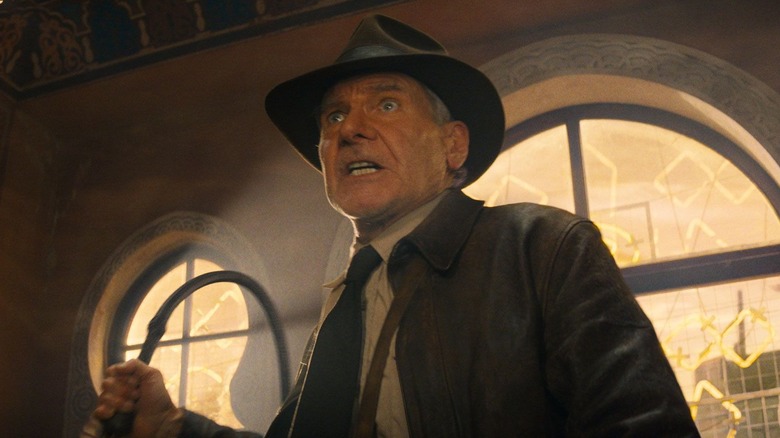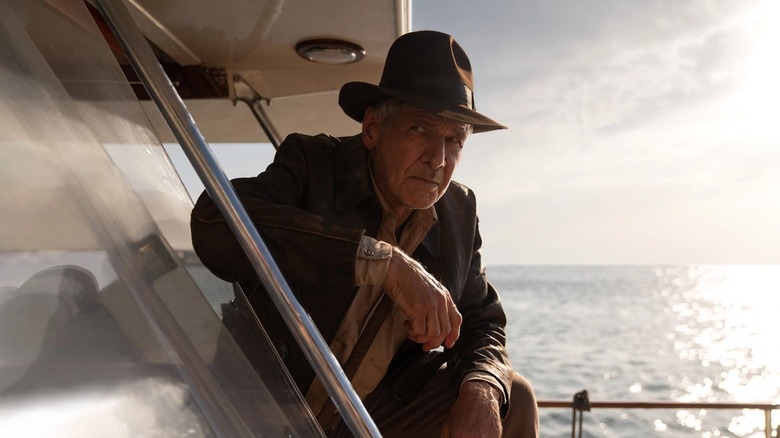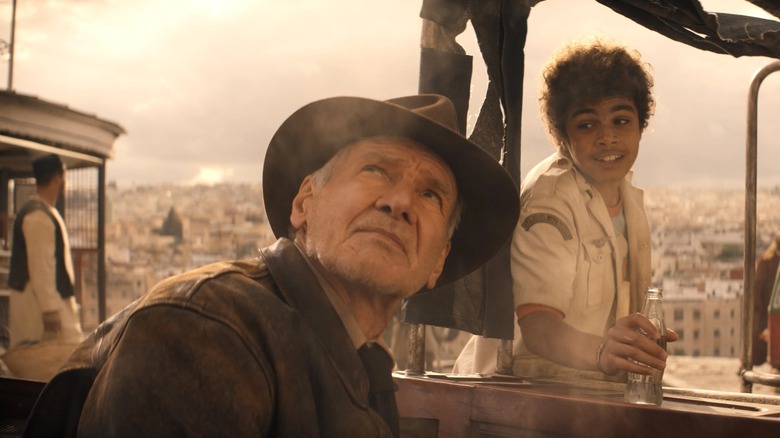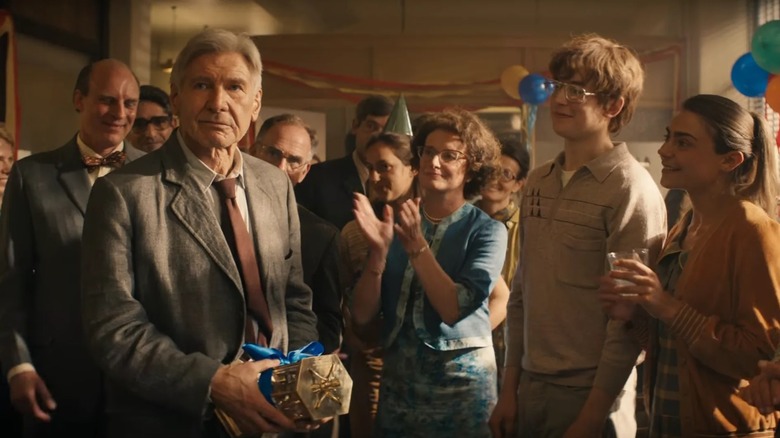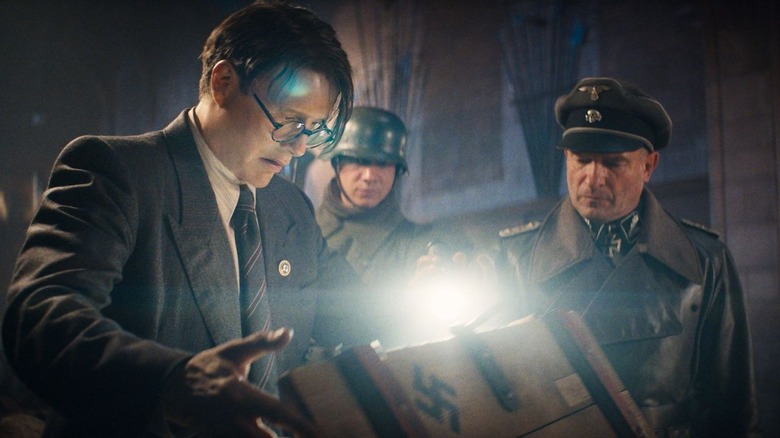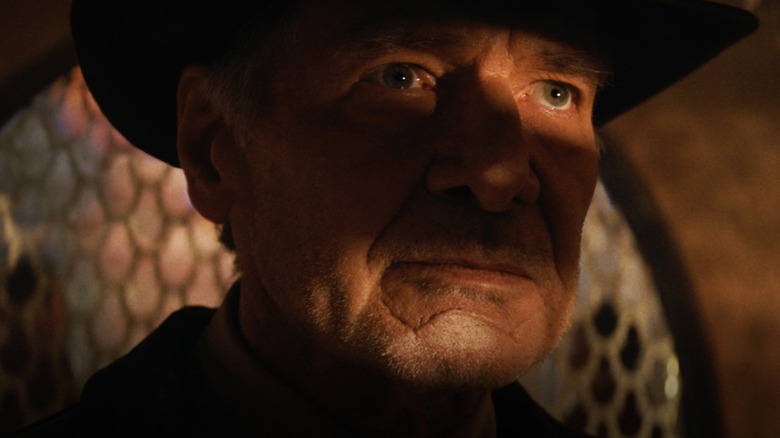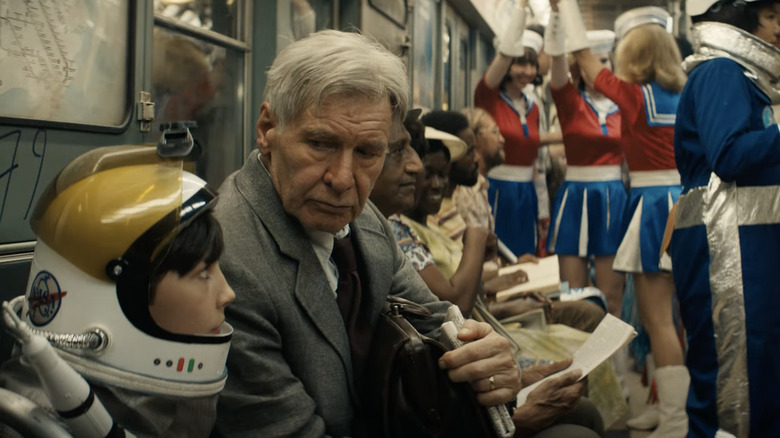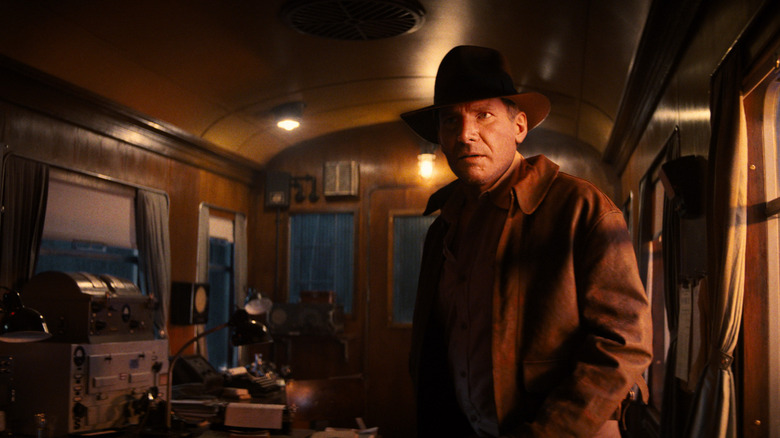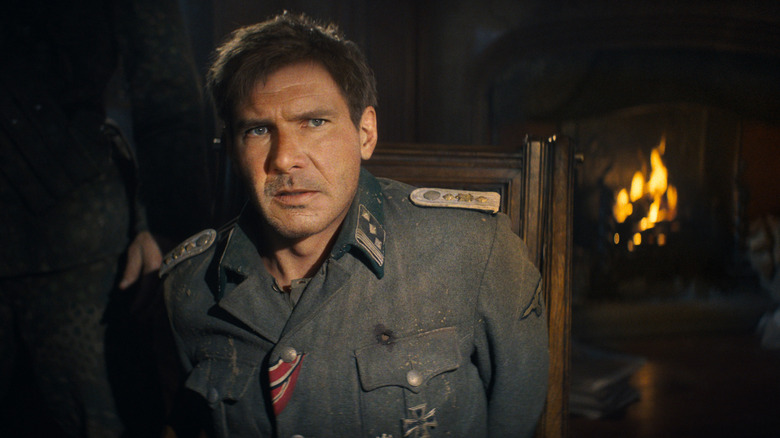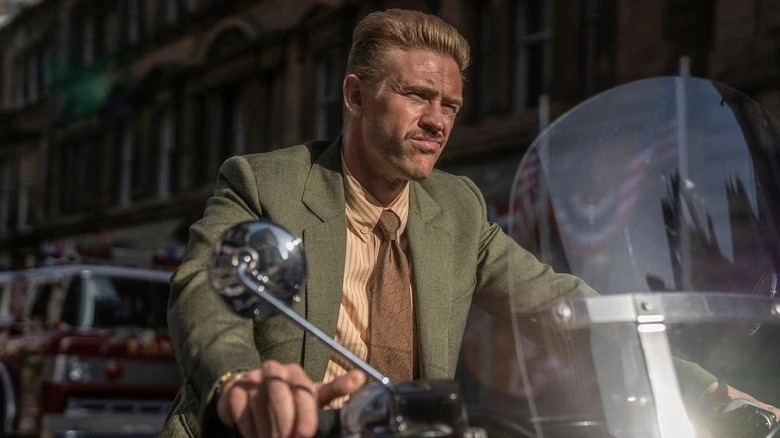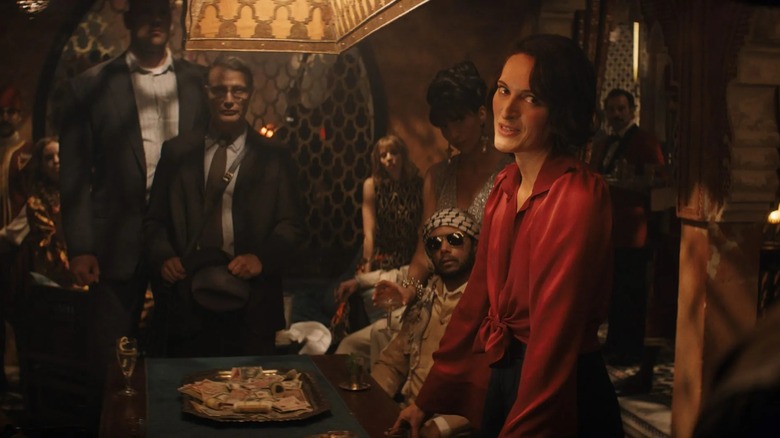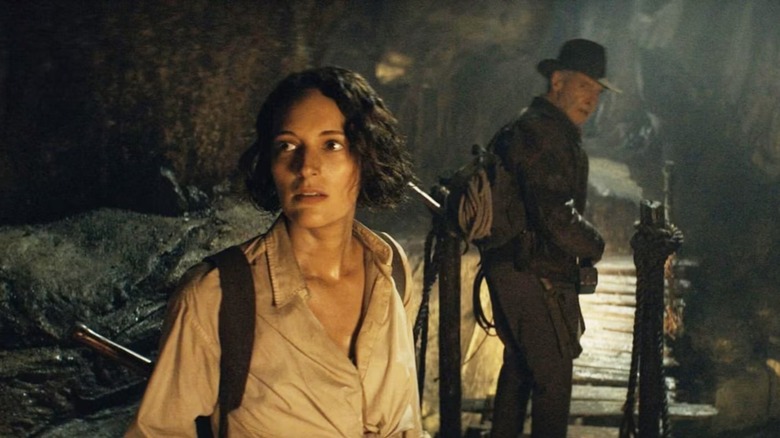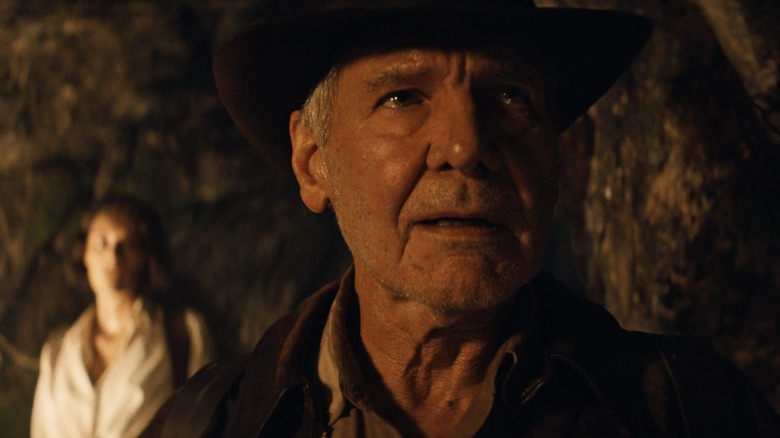The Untold Truth Of Indiana Jones And The Dial Of Destiny
You can't keep a good adventurer down. Indiana Jones has consistently proven this truism in movies like "Raiders of the Lost Ark" and "Indiana Jones and the Last Crusade." This archeologist always gets out of the toughest scrapes imaginable. For his fifth movie, "Indiana Jones and the Dial of Destiny," Indy has to face a slew of new challenges on the silver screen, but he encountered even more obstacles behind the scenes. Given the glorious box office track record of this franchise, one might imagine that getting a new "Indiana Jones" film off the ground would be a cakewalk; however, realizing "Indiana Jones and the Dial of Destiny" was anything but an easy quest, even after it had its director and screenwriters in place.
Let's take a gander at this movie's journey from conception to its release date. There's a lot to talk about, from Steven Spielberg's reasons for not directing this installment to Harrison Ford's stunt work, among many other elements. "Dial of Destiny" faced a lot of turmoil, but luckily, if there was any fictional character who could endure all those obstacles, it would have to be the one and only Indiana Jones.
The very first release date for a fifth Indiana Jones
Once Disney bought Lucasfilm in October 2012, it was immediately clear that the studio would be embarking on a slew of new "Star Wars" movies. However, it wasn't quite as apparent what the future of "Indiana Jones" would be under its new owners. Rumors abounded for the first few years of Lucasfilm's Disney ownership that the Mouse House was planning a new "Indiana Jones" title, but nothing concrete ever emerged. However, that all changed in March 2016 when Disney finally pulled the trigger and revealed that the studio had concrete ambitions for a fifth installment in this beloved adventure saga.
This news revealed that director Steven Spielberg and leading man Harrison Ford would both be returning in their respective roles for a fifth "Indiana Jones" movie while a July 19, 2019, release date was set for the project. At the time, there was a lot about this production that was still totally unknown, including who would write it, what the MacGuffin of this installment would be, and what other cast members from earlier "Indiana Jones" adventures would return. However, this release date announcement solidified Disney's interest in continuing the "Indiana Jones" saga and gave fans of the franchise something new to look forward to. Little did those fans know, though, just how long it would take for the movie that would become "Indiana Jones and the Dial of Destiny" to hit theaters.
Disney's legal wrangling to make more Indiana Jones
Per the book "The Complete Making of Indiana Jones," in the late 1970s, Paramount Pictures made a deal to distribute "Raiders of the Lost Ark." As part of this arrangement, Paramount also secured distribution rights to a quartet of "Indiana Jones" sequels. In the years that followed, this famous archeologist went on several other adventures, including the 2008 installment "Indiana Jones and the Kingdom of the Crystal Skull." However, the "Indiana Jones" saga only fulfilled three of the four sequels Paramount Pictures was entitled to. If Disney was planning on embarking on a fifth "Indiana Jones," it would first need to contend with Paramount's potential role, or lack thereof, in the proceedings.
In late 2013, Disney secured a deal with Paramount that gave Disney distribution rights to "Indiana Jones and the Dial of Destiny" and any other "Indiana Jones" movies made afterward. However, Paramount wasn't going to emerge from this deal without some rich prizes of its own. The studio arranged to have permanent distribution rights to the first four "Indiana Jones" movies while also securing a share of the profits from any future "Indiana Jones" feature. Paramount doesn't have to lift a finger on the financing and marketing of these blockbusters and could still get a hefty amount of cash from their box office runs. It was a lucrative deal for all involved and paved the way for a fifth "Indiana Jones" to finally get made over at Disney.
Why did Steven Spielberg depart Dial of Destiny?
In early 2020, momentous news broke that would forever change the "Indiana Jones" saga: Steven Spielberg stepped down from directing "Indiana Jones and the Dial of Destiny." Having directed all four of the preceding installments, Spielberg had been associated with Indy for roughly four decades when he departed the fifth movie. He had also toiled away on the potential fifth "Indiana Jones" adventure for four years — a substantial amount of time to dedicate to a project he wound up leaving. It was a staggering development, though apparently it was entirely the director's decision.
Variety reported that Spielberg didn't walk away because of creative differences with Disney. Instead, Spielberg wanted a new generation of directors to leave their mark on the property. At the time, Spielberg was planning to still have some creative input on the production in the role of producer. Even with the loss of one of the architects of the entire franchise, "Indiana Jones and the Dial of Destiny" wouldn't be deprived of a director for long. The news of Spielberg's departure was accompanied by the revelation that "Logan" director James Mangold was in talks to take over.
Why did it take so long?
In the 1980s, audiences got to experience a trio of "Indiana Jones" adventures released in relatively close proximity to one another. After "Indiana Jones and the Last Crusade" in 1989, though, moviegoers began to experience much longer wait times between installments. There was an almost 20-year gap between "Last Crusade" and "Indiana Jones and the Kingdom of the Crystal Skull" while another 15-year wait occurred between the latter film and "Dial of Destiny." In an age where multiple Marvel Cinematic Universe movies arrive in theaters each year, the lengthy waits between "Indiana Jones" installments are a rarity in the blockbuster movie landscape.
Harrison Ford explained to Digital Spy that taking so long to get the fifth movie in theaters wasn't the intentional plan. There were several attempts to get a fifth "Indiana Jones" movie made very quickly after "Crystal Skull," but none of the concepts for this sequel ever seemed right. This left Ford and other key creative principals waiting on the perfect narrative for Indiana Jones' fifth outing. Eventually, the plot of "Dial of Destiny" presented itself and Ford felt it was perfect for an "Indiana Jones" adventure. From there, the gears began turning, and the "Dial of Destiny" creative team began working on a movie that could live up to the lengthy wait.
The pandemic gave James Mangold time to put his stamp on the script
"Indiana Jones and the Dial of Destiny" director James Mangold almost didn't helm this project. As the filmmaker explained to Den of Geek, when he was initially approached for the gig in early 2020, Lucasfilm had tight plans for getting the feature out in time for the summer of 2021. While Mangold was intrigued about the prospect of working on an "Indiana Jones" movie, he felt the schedule was too tight for him to live up to his own standards. There didn't seem to be any solution to this scheduling conflict ... until the COVID-19 pandemic hit and shut down the entertainment industry.
"Indiana Jones and the Dial of Destiny" couldn't meet its initial summer 2020 shooting schedule, so the feature was postponed to accommodate the global health crisis. With this delay, Mangold found a much more accommodating schedule that benefited him creatively. Now having the proper space to prep for an "Indiana Jones" movie, Mangold signed on to direct. From there, he and "Ford v. Ferrari" screenwriters Jez and John-Henry Butterworth used their newfound creative frame to rewrite the "Dial of Destiny" script to more heavily emphasize Indy's age. The unthinkable horrors of 2020 had lots of bizarre ripple effects, including giving James Mangold the time he needed to properly helm an "Indiana Jones" installment.
James Mangold wanted to embrace an older Indy
"Indiana Jones and the Dial of Destiny" came to fruition a little more than 40 years after "Raiders of the Lost Ark," the inaugural "Indiana Jones" movie. After all that time, Harrison Ford is no longer a spring chicken, and "Dial of Destiny" makes no attempt to ignore that reality. Shifting the action to the year 1969, the feature heavily emphasizes that Indy is an elderly man adrift in the modern world. James Mangold explained to The Hollywood Reporter that he and Ford were convinced from the get-go that this had to be a core theme of "Dial of Destiny." Both men felt that it would be a grave mistake to ignore the age of the story's leading man.
Mangold was especially enamored with exploring the idea of how an older Indy might be a disillusioned human being who experienced incredible sights yet nevertheless became hardened about the wider world. This concept was reinforced by the plot of "Dial of Destiny," which leans into the moral ambiguity of the world in 1969, when the lines between heroes and villains started getting murky. By acknowledging the mortality of both Indiana Jones and Ford, Mangold found ripe themes he could explore to give "Dial of Destiny" a distinct identity compared to its predecessors.
Harrison Ford was still gung-ho about doing stunts
Though "Indiana Jones and the Dial of Destiny" makes no attempts to conceal the age of its leading man, that didn't mean Harrison Ford was sitting on the sidelines during the shoot for this action-packed blockbuster. On the contrary, James Mangold was astonished by just how much of an active role Ford wanted to take when it came to the stunt-heavy sequences of "Dial of Destiny." Mangold recalled to The Hollywood Reporter how he often had to function as the person who would step in to prevent Ford from doing some stunts that were too extreme, since this actor was always up for whatever mayhem this role offered up.
Of all the stunts that wore Ford down the most on the "Dial of Destiny" set, though, it was the simple act of getting tossed to the ground by bad guys that proved most arduous for the actor. Decades of stunt-heavy roles have impacted Ford's body and made colliding with the ground repeatedly during the shoot a difficult experience. Still, Ford kept pursuing this and other stunts throughout "Dial of Destiny" with remarkable levels of tenacity. Both Indiana Jones and Harrison Ford may be older but judging by Ford's behavior towards stunts while shooting "Dial of Destiny," a day hasn't passed when it comes to the actor's commitment to action.
Harrison Ford's thoughts on digital de-aging
"Indiana Jones and the Dial of Destiny" opens with a lengthy prologue set in the final days of World War II that establishes its titular MacGuffin and reinforces the heroic reputation of its hero. To realize this scene set in the 1940s, Harrison Ford had to be digitally de-aged by nearly 30 years. This makes "Dial of Destiny" the newest blockbuster — alongside the likes of "Rogue One," "The Adam Project," and "The Flash" — to utilize this innovation in visual effects technology to turn back the clock on recognizable actors. For good and for ill, this visual effects technique often draws very pronounced reactions and Harrison Ford's response to seeing himself digitally de-aged was no different.
Talking on "The Late Show with Stephen Colbert," Ford remarked how initially startled he was by the vividness of the effect, which was built on hours and hours of archival footage of him that Lucasfilm preserved over the years. The amount of information utilized for this de-aging astonished Ford, as did the results of this digital process, which Ford joked matched what he saw whenever he gazed at a reflection of his face in a mirror. No wonder Ford was impressed by this technique — he likely couldn't have even imagined this process existing when he was shooting "Raiders of the Lost Ark" decades earlier.
John Williams wasn't originally going to score the entire movie
While director Steven Spielberg sat out "Indiana Jones and the Dial of Destiny," other key figures of the "Indiana Jones" franchise returned for the fifth installment. In addition to leading man Harrison Ford, composer John Williams also returned to deliver a bevy of new orchestral tracks for this adventure film. Hearing the new pieces of music Williams conjured up for "Dial of Destiny" is a remarkable experience; the composer is just as creative and exciting as he was in the 1980s when the original "Indiana Jones" movies were released. Given the superb quality of his work on "Dial of Destiny," it's incredible to realize that he was initially not going to compose the entirety of this installment.
At Star Wars Celebration 2023 (via CinemaBlend), Mangold revealed that his initial plan was simply to ask Williams to deliver some new themes for "Dial of Destiny." However, once Williams saw "Dial of Destiny," he began writing more than just a few tracks for the movie. Williams proceeded to quickly write up hours of new music and was not going to be limited to just a handful of themes. Instead, Williams proved as important sonically to "Dial of Destiny" as he was to all four of the preceding "Indiana Jones" installments.
Phoebe Waller-Bridge was thrilled to do action scenes
The career of Phoebe Waller-Bridge is incredibly impressive; however, most of her efforts in front of the camera have been grounded comedic performances — save for a motion-capture role in the Lucasfilm blockbuster "Solo: A Star Wars Story" — rather than projects that forced her to get in touch with her inner John Wick. In "Indiana Jones and the Dial of Destiny," she got to play a character who kicks people as often as she delivers witty dialogue with the role of Helena Shaw — the roguish goddaughter of Indiana Jones who's chock full of secrets.
Waller-Bridge happily explained to Geek Culture that her favorite part of "Dial of Destiny," bar none, was getting to do action sequences. Working with simulated rain and people decked out head-to-toe in green suits proved to be such a memorable experience for Waller-Bridge that she didn't want it to be over once the principal photography was finished. She especially enjoyed shooting a lengthy motorbike chase scene, which gave her such an immense sense of joy that it cemented her love for shooting action sequences. After these experiences, perhaps Waller-Bridge will enter a new action-dominated era in her acting career.
Phoebe Waller-Bridge was never meant to take over the role of Indiana Jones
In the years leading up to the theatrical release of "Indiana Jones and the Dial of Destiny," rumors abounded over certain potential plot points and character arcs. One rumor that just wouldn't die was that Phoebe Waller-Bridge's Helena Shaw was being set up as a replacement for Indiana Jones in future installments of the series. James Mangold took to Twitter in December 2022 to debunk this rumor, concretely stating that there were never any plans in any incarnation of "Dial of Destiny" for somebody else to take over the moniker of Indiana Jones. While having a filmmaker be this decisive publicly would seem to be a good way to end all this speculation, the Internet is going to do Internet stuff, and speculation about Helena taking over as the new lead of the franchise persisted.
These whispers endured so prominently that Waller-Bridge was even asked about taking over the "Indiana Jones" movies by Deadline at the "Dial of Destiny" premiere. Waller-Bridge's response to that query was to brush it off, remarking that this was the very first time she'd even heard of that possibility. With that, one would expect the book to be closed on this particular rumor. However, new comments from Lucasfilm president Kathleen Kennedy to Variety indicating that Helena Shaw could lead her own movie in the future will undoubtedly start up the rumor mill once more. It's also noteworthy that Kennedy emphasized Lucasfilm is focused on its current "Indiana Jones" movie and isn't "having any of those conversations right now," regarding a "Helena Shaw" film.
Steven Spielberg's response to Dial of Destiny
When James Mangold stepped in to direct "Indiana Jones and the Dial of Destiny," he wasn't just directing another blockbuster sequel. He was helming a fresh installment in a series defined by director Steven Spielberg, whose distinct visual and thematic sensibilities had defined the very heart of this franchise. That put a lot of pressure on Mangold to live up to, especially during the inevitable moment when Spielberg watched the finished film. It's impossible to comprehend how nerve-wracking that experience must have been for Mangold, having the master of "Indiana Jones" movies judge his efforts on "Dial of Destiny."
However, Mangold didn't need to worry. Spielberg revealed at the Time 100 Summit (via Variety) in April 2023 that he'd recently seen "Indiana Jones and the Dial of Destiny" and that he thoroughly enjoyed it. In fact, Spielberg's greatest complaint with it was that it upended his notion that only he could produce quality "Indiana Jones" movies. It had been an incredibly long journey to the big screen for this fifth "Indiana Jones" movie even before the COVID-19 pandemic and the loss of Spielberg from the director's chair. Spielberg's approval of Mangold's handling of this adventurer, though, provided a pleasant end to the creative exploits of everyone who worked on "Dial of Destiny."
